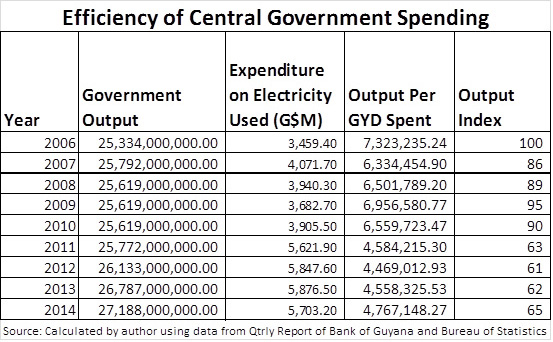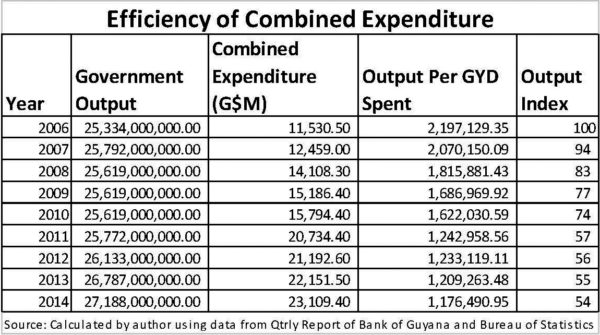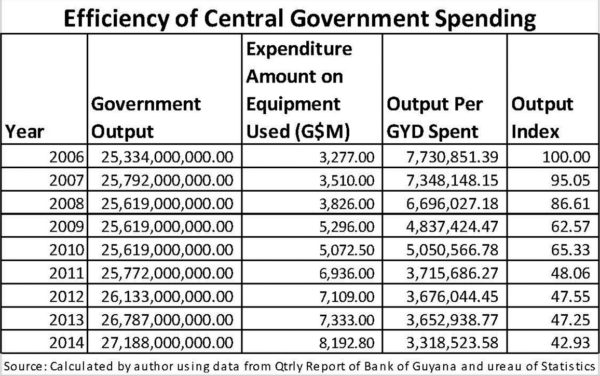Labour productivity
 As noted in the first part of this article, six inputs based on physical units or items of expenditure were selected to form an opinion of the stewardship of the previous administration over the affairs of the nation. Labour represented the physical unit and was the first item examined. It would be recalled that labour productivity was not high and kept declining from the base year of 2006, even as government kept employing more people and kept reporting that output was increasing. This state of affairs suggests that other factors would have contributed to the growth in the output of the central government. The expectation one has then in examining the number is that the efficiency level of some of the expenditure variables would be significantly higher than that of labour to create the possibility that government output was increasing as reported. The five expenditure categories used are equipment, electricity, transportation, rental of offices and fuel consumption. They were chosen because each represents a substantial portion of current expenditure by government. They also form part of the substantive policy of government, in other words, services that government must provide.
As noted in the first part of this article, six inputs based on physical units or items of expenditure were selected to form an opinion of the stewardship of the previous administration over the affairs of the nation. Labour represented the physical unit and was the first item examined. It would be recalled that labour productivity was not high and kept declining from the base year of 2006, even as government kept employing more people and kept reporting that output was increasing. This state of affairs suggests that other factors would have contributed to the growth in the output of the central government. The expectation one has then in examining the number is that the efficiency level of some of the expenditure variables would be significantly higher than that of labour to create the possibility that government output was increasing as reported. The five expenditure categories used are equipment, electricity, transportation, rental of offices and fuel consumption. They were chosen because each represents a substantial portion of current expenditure by government. They also form part of the substantive policy of government, in other words, services that government must provide.
Flexibility
Government has the flexibility to increase or decrease expenditure through its current budget to meet its priority service interests. One would expect that government would also seek to deliver services in the most cost-effective manner. After all, that is part of the theme of structural adjustment programmes. The indices that are generated from the data give an indication of how well the previous government managed its current expenditure in pursuit of poverty alleviation and within the context of a low-carbon development strategy. The outcome shown in the various tables do not reflect prudence in spending and efficiency in output. Instead, it appears to suggest that the previous administration was more interested in expanding its spending as much as possible, despite the poor quality and delivery of service to the public. Without more data, one could only speculate about the purpose of government spending and who the beneficiaries were. It is known that not all government spending aims to match a particular output. Other factors of a social and political nature intervene to alter the course of government spending and could render the budgeted objectives mute. One therefore needs to make allowance for expenditures of an unexpected nature.
Recurrent
The expenditure categories looked at is of a recurrent nature which meant that past experience should have helped to shape future expenditures. Yet, a look at the combined effect of the five expenditure categories over the years calls into question the extent to which future spending by the previous administration was informed by past experience. Table 2 below shows the total expenditure of the five categories per year. The data provides evidence that spending by government was not necessarily concerned with what happened before. The output index shows the extent to which efficiency levels were falling over the years. Output per dollar spent declined 46 per cent from 2006 to 2014. In reality, the value of the services gotten from the money spent declined each year as perhaps complacency in governing set in.
TABLE 2
The combined data masks the behaviour of each expenditure category. It does not tell readers how good or bad each expenditure category performed or which may have contributed to the positive growth in the output, if at all, of the central government. To do so in separate tables could make the article longer than the writer wishes it to be. Consequently, only two other tables would be used to indicate the behaviour of government’s performance. One table will show the expenditure category with the largest decline in efficiency and the other will show the expenditure category with the smallest decline in efficiency. These are equipment purchases and electricity purchases respectively.
Similar level
Observation of the remaining three expenditure categories reveals that they too declined in efficiency. However, resources were allocated at the same rate, 8.4 per cent, to these three expenditure categories and they all averaged a similar level of decline, 45 per cent, in efficiency. Transportation, one of the three categories, actually increased its efficiency in 2007 by 12 per cent and showed a more variable performance over the period than the rest of the expenditure categories, improving its contribution in 2009 and 2012. Fuel showed some improvement in 2009 after which its contribution to output declined on an annual basis. Rental and maintenance showed no improvement at all during the period of review.
Morality and social justice
As in the case of labour, in measuring the impact of each expenditure category, it is assumed that all other factors were held constant. While this approach is a simplification of the issue, it helps readers to see and understand the impact of each expenditure category on its own on the efficiency of government spending. The issue here is whether the amount of work that the government reportedly did justified the level of expenditure and the rate at which resources were allocated to the various expenditure categories.
Issues of morality and social justice may even lead some to query the validity and veracity of the level of output claimed by the government in the face of the evidence contained in the Tables. Even as one seeks to draw such conclusions, it must be kept in mind that government expenditure covers the work of several ministries and departments and a variety of issues. This analysis would not reveal which ministry or department or which issues made government performance look as poorly as it did during the period of 2006 to 2014.
Highest expenditure
Of the five expenditure categories chosen, the highest expenditure by government was in the area of equipment. Over the period in review, the government spent an average of $6 billion per year on equipment used in its work. It was also a preferred category of government spending, allocating resources to it faster than to any other category in the analysis. Table 3 below contains the annual output of the central government and the money spent on equipment used to generate that output. The data in the Table reveals a rather unsatisfactory trend in the performance of government. Even though government more than doubled the money spent on equipment and related items used in service to people, the efficiency of its performance went in the opposite direction and represented the largest decline in government efficiency. Except in 2010 when there was a two per cent improvement in efficiency over 2009, the efficiency output was consistently on a downward trend. While one might make room for unforeseen contingencies that lead to higher spending, the consistent decline in efficiency points to a different cause of the problem. What is clear is that more equipment will not solve a problem unless people are prepared to use it well to do the work. Labour productivity therefore remains an important bone of contention.
TABLE 3
Table 4 below deals with the money spent on electricity and the impact that that expenditure had on government output. It turns out that government departments were not efficient users of electricity, even though this expenditure category exhibited the smallest decline in efficiency. It also received allocations at a slower pace than the other four categories of expenditure. However, the fact that efficiency showed the smallest decline in this category of expenditure could result from some additional factor. One could assume therefore that efforts at energy conservation may have helped to improve the impact of expenditures in this area.
TABLE 4
Difficult to understand
On the basis of the foregoing, it is difficult to understand how the previous administration could boast about great performance. The areas of the economy for which it has direct responsibility were not well managed. This outcome points to a larger problem that might be connected to an inability to execute works in a satisfactory and timely manner. The result of this is output actually being lower than it should be.
LUCAS STOCK INDEX
The Lucas Stock Index (LSI) rose 1.16 per cent during the second period of trading in September 2016. The stocks of four companies were traded with 129,973 shares changing hands. There were two Climbers and one Tumbler. The stocks of Banks DIH (DIH) rose 13.64 percent on the sale of 7,891 shares while the stocks of Sterling Products Limited (SPL) rose 0.63 per cent on the sale of 1,608 shares. The stocks of Guyana Bank for Trade and Industry (BTI) fell 7.68 per cent on the sale of 115,000 shares. In the meantime, the stocks of Demerara Tobacco Company (DTC) remained unchanged on the sale of 5,474 shares.









